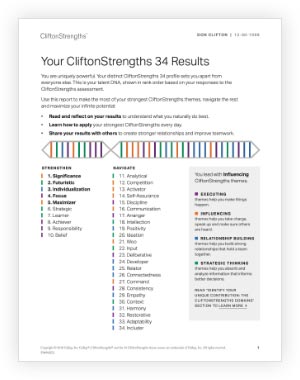Story Highlights
- Successfully managing conflict in the workplace can improve collaboration
- Ignorance of natural talents can create workplace conflict
- Open discussion of CliftonStrengths can reduce team conflict
An effective conflict resolution strategy creates tighter collaboration and a more cohesive team. Ineffective strategies paper over serious problems and nourish distrust. If knowing which is which was easy, managers wouldn't be frustrated by conflict as often as they are.
But there is a key to conflict resolution inside of every employee: the patterns of thought, feeling and behavior -- Gallup calls them CliftonStrengths -- that filter their concept of the world. When colleagues' concepts don't align, opposition can arise. And when people feel threatened, anxious or wounded, those differences can combust into team conflict.
To resolve that conflict, managers need to help their employees map their behavior back to its source. The point isn't to show opposing factions how similar they are. Just the opposite: It's to show them they're different -- and that those differences are the key to a mutually acceptable solution. That not only reduces managers' frustration, but it also creates a higher-performing team.
Managing Conflict Resolution With CliftonStrengths
A person's CliftonStrengths results reveal their patterns of thought, feeling and behavior rank ordered by intensity: The five themes at the top have the most influence on their behavior, and the five at the bottom have the least influence. And whatever the strengths motivate -- the drive to develop, for example, or compete -- is a pathway to greatness. That means differences of opinion, approach or rationale are very often just expressions of different strengths.
An effective conflict resolution strategy creates tighter collaboration and a more cohesive team. Ineffective strategies paper over serious problems and nourish distrust.
Explaining this concept to each employee separately is the first step to team conflict resolution. Such conversations indicate where each person's energy is coming from -- maybe it's a need to get things moving, or preserve a process, or perfect a product. That helps combatants understand the decision-making and emotional processing that brought each to the point of disagreement.
After that, managers can make the two world views congruent and coherent by bringing the employees together.
Conflict Resolution Basics, Bracketed by Strengths
Face-to-face meetings are generally encouraged so that participants can see emotional cues. Of course, neurodivergent employees may find that unhelpful or worse. And virtual meetings might be more comfortable for less assertive people and those who need time to think before they speak -- especially if their counterpart tends to dominate emotional space.
Still, the format matters less than the purpose, which the manager should state loud and clear: finding a mutually acceptable way to coordinate participants' strengths toward a result the whole team is accountable for.
Standard conflict resolution techniques -- behaving as a mediator (not a judge), requiring respectful behavior, assuming positive intent, identifying the goal, and explaining the risks and rewards of the situation -- are still necessary. And those practices help managers avoid certain traps.
Mediation, for instance, allows managers to make sure both sides are heard. And many times, both sides have valid points, making it especially tough for fairness-minded managers to suggest a plan forward that favors one employee's views over the other's. And mediation allows managers to avoid fact-finding missions that eat a lot of time.
Requiring respectful behavior -- no shouting, wait your turn to speak, active listening -- is not only constructive, but it also reflects the company's values. Preserving those values gives managers credibility and helps them keep the group focused on the root cause of the problem rather than the personalities around the table. That can take the emotional temperature down considerably.
So can explaining the risks and rewards. Managers who detail the time and effort necessary to resolve the issue and achieve the identified goal highlight the importance of the employees' time, which proves they are important (which may go a long way to resolving the issue) and demonstrates that the manager cares about them.
Conflict Resolution in Relationships: A Strengths-Based Approach
Setting the stage for strengths-based resolutions can help, too.
- Keep each person's top five CliftonStrengths visible so their motivators are never hidden.
- Begin the meeting with the reminder that dissent and condemnation are two different things, and all strengths help the team achieve its goals.
- Ask each person to read the other's top five strengths aloud; what we say has more impact on us than what we hear.
Say, for example, turnaround time on a software project is slow, and Hannah and Marcus need to increase efficiencies. They can't agree on the source of the problem, and it's gone on so long they're starting to think the other person is the problem.
They're both right, a little bit. Hannah has a need to chalk up wins and take charge of situations. But Marcus wants to see a connection between yesterday and today and feel his point of view has influence. That is, their strengths could help resolve tension if they are used well -- but they're not.
So, after reminding them that the right outcome is faster turnaround time and familiarizing Hannah and Marcus with each other's strengths profile, their manager should get down to it: "Hannah, it sounds to me like you're frustrated with the lack of progress, and you're not feeling heard. But charging ahead in the wrong direction leads to the wrong outcome. Marcus, I'm hearing that the lack of continuity in the project makes you uncomfortable and you're not feeling heard. But sometimes the original blueprint needs to be revised."
Hannah's and Marcus' strengths aren't congruent. They can't be -- they are unique individuals. But they can be made coherent with a third piece that bridges their individual motivations. In this case, that's probably a partner with the ability to locate the through-line from the past to the future to satisfy Marcus with metrics that prove progress to satisfy Hannah.
That's enough to resolve the conflict and get the project moving again. But it won't make Hannah and Marcus better collaborators, and it certainly won't make them friends.
From Workplace Conflict to Collaboration
For that, their manager needs to help them see how their strengths are complementary. That's a separate conversation, but it should come quickly. Hannah and Marcus need to see that they can trust each other -- and their strengths explain why. Strengths-based conflict resolution doesn't replace the basics; it brackets them, enabling coworkers to resolve their conflict more effectively.
But let's not be naïve: A conflict may be a power struggle or a need to win for winning's sake. In that case, employees need to see how their strengths, if poorly expressed, can fuel conflict. The Competition strength, for instance, can create a "me vs. you" dynamic between coworkers. But when it's properly focused on actual competitors, it can be an inexhaustible resource.
Every strength is like that in some way, and managers who point those strengths in the right direction make them far more constructive. That can diminish the hostility in a bad dynamic, too -- and take a frustrating task off the manager's calendar. And when managers provide assignments that unite employees' complementary strengths, those teams will have a chance to build their own bridge and amplify the power of their strengths. Alliances like that accomplish incredible things. That's what managers aim for with conflict resolution: powerful partnerships.
Sure, it's nice to ease tension on a team. It's good to get work moving again. And it's great to solve a problem permanently so a manager doesn't have to play whack-a-mole with the same issue over and over.
But the ideal resolution doesn't just solve a conflict. It creates a new dynamic that unites the best of different patterns of thought, feeling and behavior. It turns combatants into collaborators. And it empowers extraordinary performance.
Demystify your team members with CliftonStrengths:
- Navigate difficult team dynamics.
- Learn the manager's role in teamwork.
- Buy CliftonStrengths for your team or yourself.





